24-cell
| 24-cell | |
|---|---|
|
Schlegel diagram (vertices and edges) | |
| Type | Convex regular 4-polytope |
| Schläfli symbol |
{3,4,3} r{3,3,4} = {31,1,1} = |
| Coxeter diagram |
|
| Cells |
24 {3,4} |
| Faces | 96 {3} |
| Edges | 96 |
| Vertices | 24 |
| Vertex figure | Cube |
| Petrie polygon | dodecagon |
| Coxeter group |
F4, [3,4,3], order 1152 B4, [4,3,3], order 384 D4, [31,1,1], order 192 |
| Dual | Self-dual |
| Properties | convex, isogonal, isotoxal, isohedral |
| Uniform index | 22 |
In geometry, the 24-cell is the convex regular 4-polytope (four-dimensional analogue of a Platonic solid) with Schläfli symbol {3,4,3}. It is also called C24, icositetrachoron, octaplex (short for "octahedral complex"), icosatetrahedroid,[1] octacube, hyper-diamond or polyoctahedron, being constructed of octahedral cells.
The boundary of the 24-cell is composed of 24 octahedral cells with six meeting at each vertex, and three at each edge. Together they have 96 triangular faces, 96 edges, and 24 vertices. The vertex figure is a cube. The 24-cell is self-dual. In fact, the 24-cell is the unique convex self-dual regular Euclidean polytope which is neither a polygon nor a simplex. Due to this singular property, it does not have a good analogue in 3 dimensions.
Constructions
A 24-cell is given as the convex hull of its vertices. The vertices of a 24-cell centered at the origin of 4-space, with edges of length 1, can be given as follows: 8 vertices obtained by permuting
- (±1, 0, 0, 0)
and 16 vertices of the form
- (±1/2, ±1/2, ±1/2, ±1/2).
The first 8 vertices are the vertices of a regular 16-cell and the other 16 are the vertices of the dual tesseract. This gives a construction equivalent to cutting a tesseract into 8 cubical pyramids, and then attaching them to the facets of a second tesseract. This is equivalent to the dual of a rectified 16-cell. The analogous construction in 3-space gives the rhombic dodecahedron which, however, is not regular.
We can further divide the last 16 vertices into two groups: those with an even number of minus (−) signs and those with an odd number. Each of groups of 8 vertices also define a regular 16-cell. The vertices of the 24-cell can then be grouped into three sets of eight with each set defining a regular 16-cell, and with the complement defining the dual tesseract.
The vertices of the dual 24-cell are given by all permutations of
- (±1, ±1, 0, 0).
The dual 24-cell has edges of length √2 and is inscribed in a 3-sphere of radius √2.
Another method of constructing the 24-cell is by the rectification of the 16-cell. The vertex figure of the 16-cell is the octahedron; thus, cutting the vertices of the 16-cell at the midpoint of its incident edges produce 8 octahedral cells. This process also rectifies the tetrahedral cells of the 16-cell which also become octahedra, thus forming the 24 octahedral cells of the 24-cell.
Tessellations
A regular tessellation of 4-dimensional Euclidean space exists with 24-cells, called an icositetrachoric honeycomb, with Schläfli symbol {3,4,3,3}. Hence, the dihedral angle of a 24-cell is 120°.[2] The regular dual tessellation, {3,3,4,3} has 16-cells. (See also List of regular polytopes which includes a third regular tessellation, the tesseractic honeycomb {4,3,3,4}.)
Symmetries, root systems, and tessellations

The 24 vertices of the 24-cell represent the root vectors of the simple Lie group D4. The vertices can be seen in 3 hyperplanes, with the 6 vertices of an octahedron cell on each of the outer hyperplanes and 12 vertices of a cuboctahedron on a central hyperplane. These vertices, combined with the 8 vertices of the 16-cell, represent the 32 root vectors of the B4 and C4 simple Lie groups.
The 48 vertices (or strictly speaking their radius vectors) of the union of the 24-cell and its dual form the root system of type F4. The 24 vertices of the original 24-cell form a root system of type D4; its size has the ratio √2:1. This is likewise true for the 24 vertices of its dual. The full symmetry group of the 24-cell is the Weyl group of F4, which is generated by reflections through the hyperplanes orthogonal to the F4 roots. This is a solvable group of order 1152. The rotational symmetry group of the 24-cell is of order 576.
Quaternionic interpretation
When interpreted as the quaternions, the F4 root lattice (which is the integral span of the vertices of the 24-cell) is closed under multiplication and is therefore a ring. This is the ring of Hurwitz integral quaternions. The vertices of the 24-cell form the group of units (i.e. the group of invertible elements) in the Hurwitz quaternion ring (this group is also known as the binary tetrahedral group). The vertices of the 24-cell are precisely the 24 Hurwitz quaternions with norm squared 1, and the vertices of the dual 24-cell are those with norm squared 2. The D4 root lattice is the dual of the F4 and is given by the subring of Hurwitz quaternions with even norm squared.
Vertices of other convex regular 4-polytopes also form multiplicative groups of quaternions, but few of them generate a root lattice.
Voronoi cells
The Voronoi cells of the D4 root lattice are regular 24-cells. The corresponding Voronoi tessellation gives a tessellation of 4-dimensional Euclidean space by regular 24-cells. The 24-cells are centered at the D4 lattice points (Hurwitz quaternions with even norm squared) while the vertices are at the F4 lattice points with odd norm squared. Each 24-cell of this tessellation has 24 neighbors. With each of these it shares an octahedron. It also has 32 neighbors with which it shares only a single vertex. Eight 24-cells meet at any given vertex in this tessellation. The Schläfli symbol for this tessellation is {3,4,3,3}. The dual tessellation, {3,3,4,3}, is one by regular 16-cells. Together with the regular tesseract tessellation, {4,3,3,4}, these are the only regular tessellations of R4.
It is interesting to note that the unit balls inscribed in the 24-cells of the above tessellation give rise to the densest lattice packing of hyperspheres in 4 dimensions. The vertex configuration of the 24-cell has also been shown to give the highest possible kissing number in 4 dimensions.
Projections
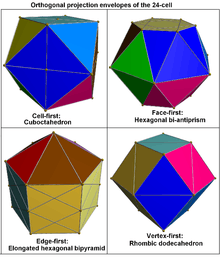
The vertex-first parallel projection of the 24-cell into 3-dimensional space has a rhombic dodecahedral envelope. Twelve of the 24 octahedral cells project in pairs onto six square dipyramids that meet at the center of the rhombic dodecahedron. The remaining 12 octahedral cells project onto the 12 rhombic faces of the rhombic dodecahedron.
The cell-first parallel projection of the 24-cell into 3-dimensional space has a cuboctahedral envelope. Two of the octahedral cells, the nearest and farther from the viewer along the W-axis, project onto an octahedron whose vertices lie at the center of the cuboctahedron's square faces. Surrounding this central octahedron lie the projections of 16 other cells, having 8 pairs that each project to one of the 8 volumes lying between a triangular face of the central octahedron and the closest triangular face of the cuboctahedron. The remaining 6 cells project onto the square faces of the cuboctahedron. This corresponds with the decomposition of the cuboctahedron into a regular octahedron and 8 irregular but equal octahedra, each of which is in the shape of the convex hull of a cube with two opposite vertices removed.
The edge-first parallel projection has an elongated hexagonal dipyramidal envelope, and the face-first parallel projection has a nonuniform hexagonal bi-antiprismic envelope.
The vertex-first perspective projection of the 24-cell into 3-dimensional space has a tetrakis hexahedral envelope. The layout of cells in this image is similar to the image under parallel projection.
The following sequence of images shows the structure of the cell-first perspective projection of the 24-cell into 3 dimensions. The 4D viewpoint is placed at a distance of five times the vertex-center radius of the 24-cell.
| Cell-first perspective projection | ||
|---|---|---|
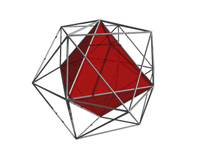 In this image, the nearest cell is rendered in red, and the remaining cells are in edge-outline. For clarity, cells facing away from the 4D viewpoint have been culled. |
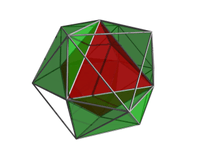 In this image, four of the 8 cells surrounding the nearest cell are shown in green. The fourth cell is behind the central cell in this viewpoint (slightly discernible since the red cell is semi-transparent). |
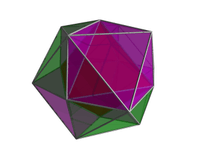 Finally, all 8 cells surrounding the nearest cell are shown, with the last four rendered in magenta. Note that these images do not include cells which are facing away from the 4D viewpoint. Hence, only 9 cells are shown here. On the far side of the 24-cell are another 9 cells in an identical arrangement. The remaining 6 cells lie on the "equator" of the 24-cell, and bridge the two sets of cells. |
 Stereographic projection | ||
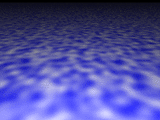 Animated cross-section of 24-cell |
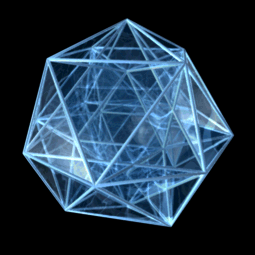 A 3D projection of a 24-cell performing a simple rotation. | |
A stereoscopic 3D projection of an icositetrachoron (24-cell). | ||
 Isometric Orthogonal Projection of: Isometric Orthogonal Projection of:8 Cell(Tesseract) + 16 Cell = 24 Cell | ||
Orthogonal projections
| Coxeter plane | F4 | |
|---|---|---|
| Graph |  | |
| Dihedral symmetry | [12] | |
| Coxeter plane | B3 / A2 (a) | B3 / A2 (b) |
| Graph |  |
 |
| Dihedral symmetry | [6] | [6] |
| Coxeter plane | B4 | B2 / A3 |
| Graph |  |
 |
| Dihedral symmetry | [8] | [4] |
Three Coxeter group constructions
There are two lower symmetry forms of the 24-cell, derived as a rectified 16-cell, with B4 or [3,3,4] symmetry drawn bicolored with 8 and 16 octahedral cells. Lastly it can be constructed from D4 or [31,1,1] symmetry, and drawn tricolored with 8 octahedra each.
| Three nets of the 24-cell with cells colored by D4, B4, and F4 symmetry | |||||||||||
|---|---|---|---|---|---|---|---|---|---|---|---|
| Rectified demitesseract | Rectified 16-cell | Regular 24-cell | |||||||||
| D4, [31,1,1], order 192 | B4, [3,3,4], order 384 | F4, [3,4,3], order 1152 | |||||||||
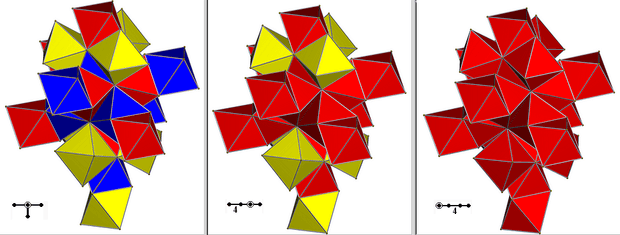 | |||||||||||
| Three sets of 8 rectified tetrahedral cells | One set of 16 rectified tetrahedral cells and one set of 8 octahedral cells. | One set of 24 octahedral cells | |||||||||
| Vertex figure (Each edge corresponds to one triangular face, colored by symmetry arrangement) | |||||||||||
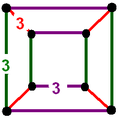 |
 |
 | |||||||||
Visualization
The 24-cell consists of 24 octahedral cells. For visualization purposes, it is convenient that the octahedron has opposing parallel faces (a trait it shares with the cells of the tesseract and the 120-cell). One can stack octahedrons face to face in a straight line bent in the 4th direction into a great circle with a circumference of 6 cells. The cell locations lend themselves to a hyperspherical description. Pick an arbitrary cell and label it the "North Pole". Eight great circle meridians (two cells long) radiate out in 3 dimensions, converging at the 3rd "South Pole" cell. This skeleton accounts for 18 of the 24 cells (2 + 8×2). See the table below.
There is another related great circle in the 24-cell, the dual of the one above. A path that traverses 6 vertices solely along edges, resides in the dual of this polytope, which is itself since it is self dual. One can easily follow this path in a rendering of the equatorial cuboctahedron cross-section.
Starting at the North Pole, we can build up the 24-cell in 5 latitudinal layers. With the exception of the poles, each layer represents a separate 2-sphere, with the equator being a great 2-sphere. The cells labeled equatorial in the following table are interstitial to the meridian great circle cells. The interstitial "equatorial" cells touch the meridian cells at their faces. They touch each other, and the pole cells at their vertices. This latter subset of eight non-meridian and pole cells has the same relative position to each other as the cells in a tesseract (8-cell), although they touch at their vertices instead of their faces.
| Layer # | Number of Cells | Description | Colatitude | Region |
|---|---|---|---|---|
| 1 | 1 cell | North Pole | 0° | Northern Hemisphere |
| 2 | 8 cells | First layer of meridian cells | 60° | |
| 3 | 6 cells | Non-meridian / interstitial | 90° | Equator |
| 4 | 8 cells | Second layer of meridian cells | 120° | Southern Hemisphere |
| 5 | 1 cell | South Pole | 180° | |
| Total | 24 cells | |||
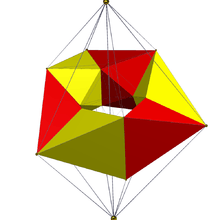
The 24-cell can be partitioned into disjoint sets of four of these 6-cell great circle rings, forming a discrete Hopf fibration of four interlocking rings. One ring is "vertical", encompassing the pole cells and four meridian cells. The other three rings each encompass two equatorial cells and four meridian cells, two from the northern hemisphere and two from the southern.
Note this hexagon great circle path implies the interior/dihedral angle between adjacent cells is 180 - 360/6 = 120 degrees. This suggests you can adjacently stack exactly three 24-cells in a plane and form a 4-D honeycomb of 24-cells as described previously.
One can also follow a great circle route, through the octahedrons' opposing vertices, that is four cells long. This corresponds to traversing diagonally through the squares in the cuboctahedron cross-section. The 24-cell is the only regular polytope in more than two dimensions where you can traverse a great circle purely through opposing vertices (and the interior) of each cell. This great circle is self dual. This path was touched on above regarding the set of 8 non-meridian (equatorial) and pole cells. The 24-cell can be equipartitioned into three 8-cell subsets, each having the organization of a tesseract. Each of these subsets can be further equipartitioned into two interlocking great circle chains, four cells long. Collectively these three subsets now produce another, six ring, discrete Hopf fibration.
Related complex polygons
The regular complex polygon 4{3}4, ![]()
![]()
![]() or
or ![]()
![]()
![]() contains the 24 vertices of the 24-cell, and 24 4-edges that correspond to central squares of 24 of 48 octahedral cells. Its symmetry is 4[3]4, order 96.[3]
contains the 24 vertices of the 24-cell, and 24 4-edges that correspond to central squares of 24 of 48 octahedral cells. Its symmetry is 4[3]4, order 96.[3]
The regular complex polytope 3{4}3, ![]()
![]()
![]() or
or ![]()
![]()
![]() , in has a real representation as a 24-cell in 4-dimensional space. 3{4}3 has 24 vertices, and 24 3-edges. Its symmetry is 3[4]3, order 72.
, in has a real representation as a 24-cell in 4-dimensional space. 3{4}3 has 24 vertices, and 24 3-edges. Its symmetry is 3[4]3, order 72.
The regular complex polygon 3{6}2, ![]()
![]()
![]() or
or ![]()
![]()
![]() contains the 24 vertices of the 24-cell. It has 16 3-edges. Its symmetry is 3[6]2, order 48.
contains the 24 vertices of the 24-cell. It has 16 3-edges. Its symmetry is 3[6]2, order 48.
| Name | {3,4,3}, |
4{3}4, |
3{4}3, |
3{6}2, |
|---|---|---|---|---|
| Symmetry | [3,4,3], |
4[3]4, |
3[4]3, |
3[6]2, |
| Vertices | 24 | 24 | 24 | 24 |
| Edges | 96 2-edges | 24 4-edge | 24 3-edges | 16 3-edges |
| Image |  24-cell in F4 Coxeter plane, with 24 vertices in two rings of 12, and 96 edges. |
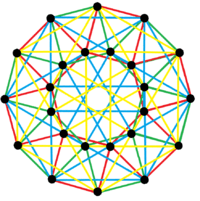 4{3}4, |
 3{4}3 or |
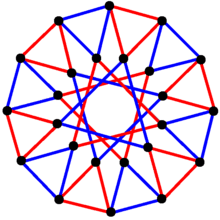 3{6}2, |
Related 4-polytopes
Several uniform 4-polytopes can be derived from the 24-cell via truncation:
- truncating at 1/3 of the edge length yields the truncated 24-cell;
- truncating at 1/2 of the edge length yields the rectified 24-cell;
- and truncating at half the depth to the dual 24-cell yields the bitruncated 24-cell, which is cell-transitive.
The 96 edges of the 24-cell can be partitioned into the golden ratio to produce the 96 vertices of the snub 24-cell. This is done by first placing vectors along the 24-cell's edges such that each two-dimensional face is bounded by a cycle, then similarly partitioning each edge into the golden ratio along the direction of its vector. An analogous modification to an octahedron produces an icosahedron, or "snub octahedron."
The 24-cell is the unique convex self-dual regular Euclidean polytope that is neither a polygon nor a simplex. Relaxing the condition of convexity admits two further figures: the great 120-cell and grand stellated 120-cell.
Related uniform polytopes
| D4 uniform polychora | |||||||||||
|---|---|---|---|---|---|---|---|---|---|---|---|
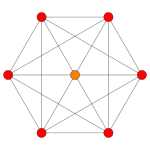 |
 |
 |
 |
 |
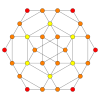 |
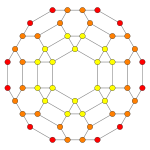 |
 | ||||
| {3,31,1} h{4,3,3} |
2r{3,31,1} h3{4,3,3} |
t{3,31,1} h2{4,3,3} |
2t{3,31,1} h2,3{4,3,3} |
r{3,31,1} {31,1,1}={3,4,3} |
rr{3,31,1} r{31,1,1}=r{3,4,3} |
tr{3,31,1} t{31,1,1}=t{3,4,3} |
sr{3,31,1} s{31,1,1}=s{3,4,3} | ||||
| 24-cell family polytopes | |||||||||||
|---|---|---|---|---|---|---|---|---|---|---|---|
| Name | 24-cell | truncated 24-cell | snub 24-cell | rectified 24-cell | cantellated 24-cell | bitruncated 24-cell | cantitruncated 24-cell | runcinated 24-cell | runcitruncated 24-cell | omnitruncated 24-cell | |
| Schläfli symbol |
{3,4,3} | t0,1{3,4,3} t{3,4,3} |
s{3,4,3} | t1{3,4,3} r{3,4,3} |
t0,2{3,4,3} rr{3,4,3} |
t1,2{3,4,3} 2t{3,4,3} |
t0,1,2{3,4,3} tr{3,4,3} |
t0,3{3,4,3} | t0,1,3{3,4,3} | t0,1,2,3{3,4,3} | |
| Coxeter diagram |
|||||||||||
| Schlegel diagram |
 |
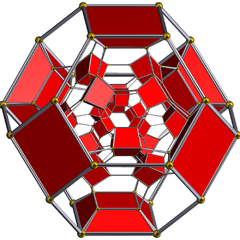 |
 |
 |
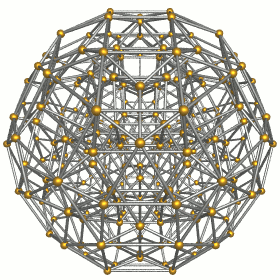 |
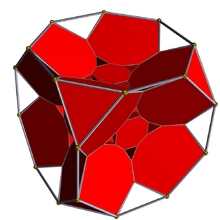 |
 |
 |
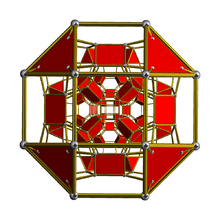 |
 | |
| F4 |  |
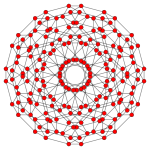 |
 |
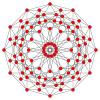 |
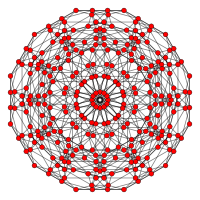 |
 |
 |
 |
 |
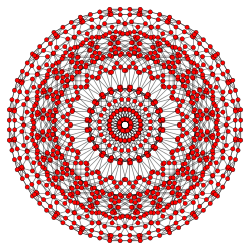 | |
| B4 |  |
 |
 |
 |
 |
 |
 |
 |
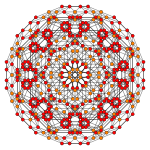 |
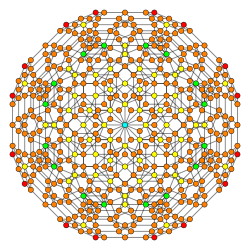 | |
| B3(a) |  |
 |
 |
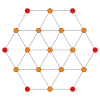 |
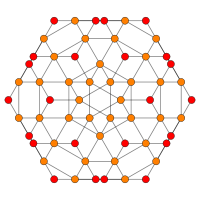 |
 |
 |
 |
 |
 | |
| B3(b) |  |
 |
 |
 |
 |
 | |||||
| B2 |  |
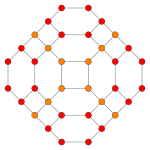 |
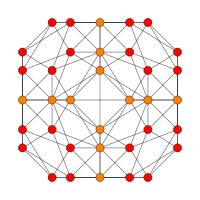 |
 |
 |
 |
 |
 |
 |
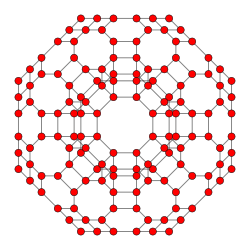 | |
The 24-cell can also be derived as a rectified 16-cell:
| B4 symmetry polytopes | |||||||||||
|---|---|---|---|---|---|---|---|---|---|---|---|
| Name | tesseract | rectified tesseract |
truncated tesseract |
cantellated tesseract |
runcinated tesseract |
bitruncated tesseract |
cantitruncated tesseract |
runcitruncated tesseract |
omnitruncated tesseract | ||
| Coxeter diagram |
= |
= |
|||||||||
| Schläfli symbol |
{4,3,3} | t1{4,3,3} r{4,3,3} |
t0,1{4,3,3} t{4,3,3} |
t0,2{4,3,3} rr{4,3,3} |
t0,3{4,3,3} | t1,2{4,3,3} 2t{4,3,3} |
t0,1,2{4,3,3} tr{4,3,3} |
t0,1,3{4,3,3} | t0,1,2,3{4,3,3} | ||
| Schlegel diagram |
 |
 |
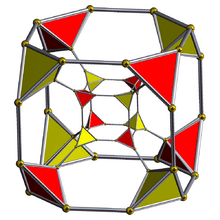 |
 |
 |
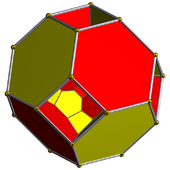 |
 |
 |
 | ||
| B4 |  |
 |
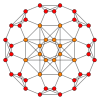 |
 |
 |
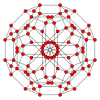 |
 |
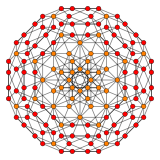 |
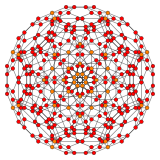 | ||
| Name | 16-cell | rectified 16-cell |
truncated 16-cell |
cantellated 16-cell |
runcinated 16-cell |
bitruncated 16-cell |
cantitruncated 16-cell |
runcitruncated 16-cell |
omnitruncated 16-cell | ||
| Coxeter diagram |
= |
= |
= |
= |
= |
= |
|||||
| Schläfli symbol |
{3,3,4} | t1{3,3,4} r{3,3,4} |
t0,1{3,3,4} t{3,3,4} |
t0,2{3,3,4} rr{3,3,4} |
t0,3{3,3,4} | t1,2{3,3,4} 2t{3,3,4} |
t0,1,2{3,3,4} tr{3,3,4} |
t0,1,3{3,3,4} | t0,1,2,3{3,3,4} | ||
| Schlegel diagram |
 |
 |
 |
 |
 |
 |
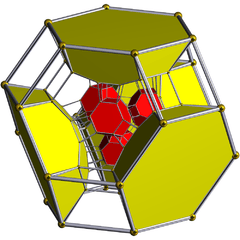 |
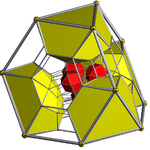 |
 | ||
| B4 |  |
 |
 |
 |
 |
 |
 |
 |
 | ||
| {3,p,3} polytopes | |||||||||||
|---|---|---|---|---|---|---|---|---|---|---|---|
| Space | S3 | H3 | |||||||||
| Form | Finite | Compact | Paracompact | Noncompact | |||||||
| {3,p,3} | {3,3,3} | {3,4,3} | {3,5,3} | {3,6,3} | {3,7,3} | {3,8,3} | ... {3,∞,3} | ||||
| Image | 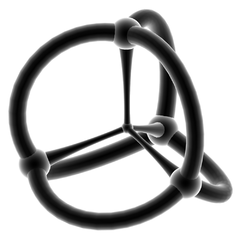 |
 |
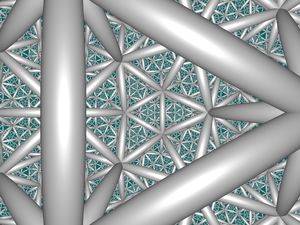 |
 |
|||||||
| Cells |  {3,3} |
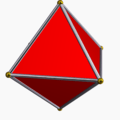 {4,3} |
 {3,5} |
 {3,6} |
 {3,7} |
 {3,8} |
 {3,∞} | ||||
| Vertex figure |
 {3,3} |
 {4,3} |
 {5,3} |
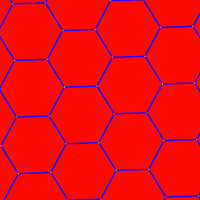 {6,3} |
 {7,3} |
 {8,3} |
 {∞,3} | ||||
See also
References
- H.S.M. Coxeter:
- H.S.M. Coxeter, Regular Polytopes, 3rd Edition, Dover New York, 1973
- Kaleidoscopes: Selected Writings of H.S.M. Coxeter, edited by F. Arthur Sherk, Peter McMullen, Anthony C. Thompson, Asia Ivic Weiss, Wiley-Interscience Publication, 1995, ISBN 978-0-471-01003-6
- (Paper 22) H.S.M. Coxeter, Regular and Semi Regular Polytopes I, [Math. Zeit. 46 (1940) 380-407, MR 2,10]
- (Paper 23) H.S.M. Coxeter, Regular and Semi-Regular Polytopes II, [Math. Zeit. 188 (1985) 559-591]
- (Paper 24) H.S.M. Coxeter, Regular and Semi-Regular Polytopes III, [Math. Zeit. 200 (1988) 3-45]
- Norman Johnson Uniform Polytopes, Manuscript (1991)
- N.W. Johnson: The Theory of Uniform Polytopes and Honeycombs, Ph.D. (1966)
- Weisstein, Eric W. "24-Cell". MathWorld.
(also under Icositetrachoron)
- Klitzing, Richard. "4D uniform polytopes (polychora) x3o4o3o - ico".
- Olshevsky, George. "Icositetrachoron". Glossary for Hyperspace. Archived from the original on 4 February 2007.
- Der 24-Zeller (24-cell) Marco Möller's Regular polytopes in R4 (German)
External links
- 24-cell animations
- 24-cell in stereographic projections
- 24-cell description and diagrams
- Petrie dodecagons in the 24-cell: mathematics and animation software
| Fundamental convex regular and uniform polytopes in dimensions 2–10 | ||||||||||||
|---|---|---|---|---|---|---|---|---|---|---|---|---|
| Family | An | Bn | I2(p) / Dn | E6 / E7 / E8 / E9 / E10 / F4 / G2 | Hn | |||||||
| Regular polygon | Triangle | Square | p-gon | Hexagon | Pentagon | |||||||
| Uniform polyhedron | Tetrahedron | Octahedron • Cube | Demicube | Dodecahedron • Icosahedron | ||||||||
| Uniform 4-polytope | 5-cell | 16-cell • Tesseract | Demitesseract | 24-cell | 120-cell • 600-cell | |||||||
| Uniform 5-polytope | 5-simplex | 5-orthoplex • 5-cube | 5-demicube | |||||||||
| Uniform 6-polytope | 6-simplex | 6-orthoplex • 6-cube | 6-demicube | 122 • 221 | ||||||||
| Uniform 7-polytope | 7-simplex | 7-orthoplex • 7-cube | 7-demicube | 132 • 231 • 321 | ||||||||
| Uniform 8-polytope | 8-simplex | 8-orthoplex • 8-cube | 8-demicube | 142 • 241 • 421 | ||||||||
| Uniform 9-polytope | 9-simplex | 9-orthoplex • 9-cube | 9-demicube | |||||||||
| Uniform 10-polytope | 10-simplex | 10-orthoplex • 10-cube | 10-demicube | |||||||||
| Uniform n-polytope | n-simplex | n-orthoplex • n-cube | n-demicube | 1k2 • 2k1 • k21 | n-pentagonal polytope | |||||||
| Topics: Polytope families • Regular polytope • List of regular polytopes and compounds | ||||||||||||
